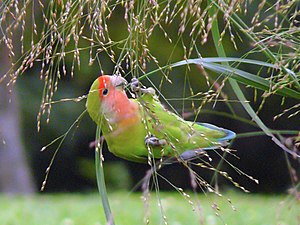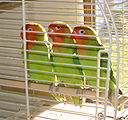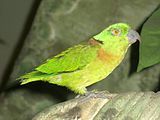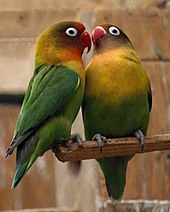Lovebird: Difference between revisions
No edit summary |
No edit summary |
||
| Line 3: | Line 3: | ||
{{Taxobox |
{{Taxobox |
||
| name = Lovebird |
| name = Lovebird |
||
| fossil_range = {{fossil range| |
| fossil_range = {{fossil range|5.332|0.000}} [[Pliocene]]–recent |
||
| status = LC |
| status = LC |
||
| status_system = IUCN3.1 |
| status_system = IUCN3.1 |
||
Revision as of 07:33, 6 December 2012
This article has multiple issues. Please help improve it or discuss these issues on the talk page. (Learn how and when to remove these messages)
No issues specified. Please specify issues, or remove this template. |
| Lovebird Temporal range: Pliocene–recent
| |
|---|---|

| |
| A feral Rosy-faced Lovebird eating seeds in Chicago, USA | |
| Scientific classification | |
| Kingdom: | |
| Phylum: | |
| Class: | |
| Order: | |
| Superfamily: | |
| Family: | |
| Subfamily: | |
| Genus: | Agapornis Selby, 1836
|
| Species | |
|
Nine - see text | |
A Lovebird is one of nine species of the genus Agapornis (Greek: αγάπη agape 'love'; όρνις ornis 'bird'). They are a social and affectionate small parrot. Seven species are native to the African continent, while the Grey-headed Lovebird is native to Madagascar. Their name stems from the parrots' strong, monogamous pair bonding and the long periods which paired birds spend sitting together. Lovebirds live in small flocks and eat fruit, vegetables, grasses and seed. Black-winged Lovebirds also eat insects and figs, and the Black-collared Lovebirds have a special dietary requirement for native figs, making them problematic to keep in captivity.
Some species are kept as pets, and several color mutations were selectively bred in aviculture. Their average lifespan is 10 to 15 years.[2]
Description
Lovebirds are 13 to 17 centimeters in length and 40 to 60 grams in weight. They are among the smallest parrots, characterized by a stocky build, a short blunt tail, and a relatively large, sharp beak. Wildtype lovebirds are mostly green with a variety of colors on their upper body, depending on the species. The Fischer's Lovebird, Black-cheeked Lovebird, and the Masked Lovebird have a prominent white ring around their eyes. The Abyssinian Lovebird, the Madagascar Lovebird. Many colour mutant varieties have been produced by selective breeding of the species that are popular in aviculture.
Taxonomy

The lovebird genus comprises nine species of which five are monotypic and four are divided into subspecies.[4] Eight of them are native in the mainland of Africa and the Madagascar Lovebird is native to Madagascar. In the wild the different species are separated geographically.
Traditionally, lovebirds are divided in 3 groups:
- 1. the sexually dimorphic species: Madagascar, Abyssinian, and Red-headed Lovebird
- 2. the intermediate species: Peach-faced Lovebird
- 3. the white-eye-ringed species: Masked, Fischer's, Lilian's, and Black-cheeked Lovebirds
However, this division is not fully supported by phylogenetic studies, as the species of the dimorphic group are not grouped together in a single clade.
Species and subspecies:[5]
- Rosy-faced Lovebird, Agapornis roseicollis, (Vieillot, 1818) — or Peach-faced Lovebird
- Agapornis roseicollis catumbella, B.P. Hall, 1952
- Agapornis roseicollis roseicollis, (Vieillot 1818)
- Yellow-collared Lovebird, Agapornis personatus, Reichenow, 1887 — or Masked Lovebird
- Fischer's Lovebird, Agapornis fischeri, Reichenow, 1887
- Lilian's Lovebird, Agapornis lilianae, Shelley, 1894 — or Nyasa Lovebird
- Black-cheeked Lovebird, Agapornis nigrigenis, W.L. Sclater, 1906
- Grey-headed Lovebird, Agapornis canus, (Gmelin, 1788) — or Madagascar Lovebird
- Agapornis canus ablectaneus, Bangs, 1918
- Agapornis canus canus, (Gmelin, 1788)
- Black-winged Lovebird, Agapornis taranta, (Stanley, 1814) — or Abyssinian Lovebird
- Red-headed Lovebird, Agapornis pullarius, (Linnaeus, 1758) — or Red-faced Lovebird
- Agapornis pullarius pullarius, (Linnaeus, 1758)
- Agapornis pullarius ugandae, Neumann, 1908
- Black-collared Lovebird, Agapornis swindernianus, (Kuhl, 1820) — or Swindern's Lovebird
- Agapornis swindernianus emini, Neumann, 1908
- Agapornis swindernianus swindernianus, (Kuhl, 1820)
- Agapornis swindernianus zenkeri, Reichenow, 1895
Species
| Species (wild-types) | |||
|---|---|---|---|
| Common and binomial names | Photograph | Description[4] | Range |
| Yellow-collared Lovebird or Masked Lovebird (Agapornis personatus) |
 |
14 cm (5.5 in) Large. Yellow and green. Has Blue tail feathers. | Northeast Tanzania |
| Fischer's Lovebird (Agapornis fischeri) |
 |
14 cm (5.5 in) long. Mostly green, orange upper body and head, blue lower back and rump, red beak, white eyerings | South and southeast of Lake Victoria in northern Tanzania |
| Lilian's Lovebird or Nyasa Lovebird (Agapornis lilianae) |
 |
13 cm (5 in) long. Mostly green including green back and green rump, orange head, red beak, white eyerings | Malawi |
| Black-cheeked Lovebird (Agapornis nigrigenis) |
 |
14 cm (5.5 in) long. Mostly green, brownish-black cheeks and throat, reddish-brown forehead and forecrown, orange upper chest, red beak, white eyerings | Zambia |
| Rosy-faced Lovebird or Peach-faced Lovebird (Agapornis roseicollis) |
 |
15 cm (6 in) long. Mostly green, orange face, blue lower back and rump, horn-coloured beak | Namibia, South Africa, Angola |
| Black-winged Lovebird or Abyssinian Lovebird (Agapornis taranta) |
 |
16.5 cm (6.5 in) long. Mostly green, red beak, some black wing feathers. Sexual dimorphism: only the male has red on forehead and crown, females plumage is all green | southern Eritrea to southwestern Ethiopia |
| Red-headed Lovebird or Red-faced Lovebird (Agapornis pullarius) |
 |
15 cm (6 in) long. Mostly green with red on upper neck and face. Sexual dimorphism: the male has more extensive and a darker red on face and head, and the male has a darker red beak than the female | Large part of central Africa |
| Grey-headed Lovebird or Madagascar Lovebird (Agapornis canus) |
 |
13 cm (5 in) long. Mostly green with darker green on back, pale grey beak. Sexual dimorphism: male has a grey upper body, neck and head. | Madagascar |
| Black-collared Lovebird or Swindern's Lovebird (Agapornis swindernianus) |
 |
13.5 cm (5 in) long. Mostly green, brown collar which has a black upper margin at the back of the neck, dark grey/black beak | Equatorial Africa |
Nesting
Depending on the species of lovebird, the female will carry nesting material into the nest in various ways. The Peach-faced Lovebird tucks nesting material in the feathers of its rump,[6] while the Masked Lovebird carries nesting material back in its beak. Once the lovebirds start constructing their nest, mating will follow. During this time, the lovebirds will mate repeatedly. Eggs follow 3–5 days later. The female will spend hours inside her nesting box before eggs are laid. Once the first egg is laid, a new egg will follow every other day until the clutch is complete, typically at four to six eggs. Even without a nest, lovebirds sometimes produce eggs.
Feral populations

Feral populations of Fischer's Lovebirds and Masked Lovebirds live in cities of East Africa. Also present there are interspecific hybrids between these two species. The hybrid has reddish-brown on head and has orange on upper chest, but otherwise resemble the Masked Lovebird.[7]
Feral lovebirds are also present in Phoenix, Arizona, USA.
Aviculture
With their inclination to bond, they can form long-term relationships with people in tandem with their intra-species companions. Aggression is easily aroused in lovebirds, however, and biting may occur unless a bond is established with gentle handling. Provided with adequate space, a stimulating environment, and appropriate nutrition, a lovebird can become a cherished companion parrot. They love to snuggle and often preen their favorite people.
It is preferable to obtain birds bred in captivity, rather than birds caught from the wild. Wild birds may be harboring a disease, such as avian polyomavirus.[8] Captured wild lovebirds also may mourn the loss of association with a mate or a flock. Their age is likely to be unknown, and they may have an unsuitable personality for domestication. Lovebirds are not necessarily best kept in pairs, as their name suggests, although relationships with humans are then less likely to be as intense when paired. Birds kept individually or brought up hand-fed, make very good pets. However, single birds require frequent attention to stay happy, and if the owner has limited time to spend daily with a single lovebird, it is preferable to grant the lovebird a companion of the same species, or a companion of another parrot species known to get along well with lovebirds. Lovebirds can become very interactive with humans, and when comfortable, will willingly perch on a finger or shoulders.
Some Lovebirds talk, but many will not: there is a chance they may learn to mimic human sounds if taught to do so at a young age. Lovebirds are noisy, with calls ranging from cheerily pleasant to highly irritating; in the wild, parrots must call to each other over long distances to keep flocks together, and it is through such signals that most of their communication is made. It is best to spend frequent, short periods of time with a lovebird, rather than having just one or two interactions every day.[9]
Gender
Determining Lovebird sex is difficult. At maturity of one year, it may show signs of whether it is male or female, such as ripping up paper and stuffing it into its feathers (female behavior) or regurgitating for its owners (male behavior: the male feeds the nesting female). This behavior is not a reliable indicator. The only sure method is DNA testing. Companies that provide such service exist.[10]
Housing and environment

Lovebirds require an appropriately sized cage or aviary. Recommended space per bird is min 1m×1m×1m. Lovebird's beaks are made of keratin, which grows continuously. Chewing and destroying wood toys and perches helps to keep beaks trim. Cuttlebones help provide beak-trimming and a source of calcium and other necessary minerals. Natural perches and special rough surfaced perches of varying diameters placed at different levels in the cage will allow greater climbing mobility and gives them a choice to select the most comfortable spot to roost.[11] They also require plenty of toys, such as willow branches, swings, tunnels, boxes and safe things to chew on and play with.
Lack of toys, keeping the birdcage covered too many hours, and lack of companionship or social stimulation may lead to boredom, stress and psychological or behavioral problems (nervousness, aggression, feather-plucking, screaming, depression, immuno-suppression). Lovebirds are extremely social birds and will enjoy several hours of interaction a day. Without this interaction, daily exercise, a roomy cage/aviary, and many toys to play with, they may resort to feather-plucking, or screaming, and both behaviors can be difficult to cure. It is suggested that if the owner leaves the house that they leave a radio or TV set playing, to provide sound.[12] Lovebirds are intelligent, and if a relationship is to form they need a human who will dedicate lots of time with them. Lovebirds enjoy baths and like to sun themselves daily.
Grooming
As with pet parrots in general, the tips of lovebirds' toenails should wear down adequately by the parrot climbing over rough surfaced perches. If the parrot has an inactive lifestyle, however, occasionally the toe nails grow long and may need to be trimmed.[13] Only the very tips of the toe nails are trimmed. If too much of a toe nail is trimmed away, it will be painful and bleed from the blood vessels in the centre of the nail.[13][14] This bleeding should be stopped as soon as possible with the use of styptic gel or powder. Sharp pointed toe nails that scratch the owner can be blunted by simply filing the point.[14] These procedures are usually done with the help of an assistant carefully holding the parrot wrapped in a towel.[13][14]
Diet
- Whole Cereals & whole Grains : amaranth, barley, couscous, flax, whole-grain Pastas, oats, quinoa, whole wheat, wild rice, whole rices.
- Edible Blossoms & Flowers: Carnations, Chamomille, Chives, Dandelion, Day Lilies, Eucalyptus, Fruit tree's blossoms, Herbs' blossoms, Hibiscus, Honeysuckle, Impatiens, Lilac, Nasturiums, Pansies, Passion Flower (Passiflora), Roses, Sunflowers, Tulips, Violets. Note that the leaves of some of these plants are poisonous to Lovebirds.
- Greens &/or Weeds:
- mainly ; Bok-Choy, broccoli and/or cauliflower leaves, cabbage leaves, Collard greens, dandelion leaves, kelp, mustard leaves, seaweeds, Spirulina, Water cress...
- occasionally & sporadically ; Amaranth leaves, Beet leaves, Carambola (Starfruit), Chards, Parsley, Spinach & Turnip leaves. All of these feature high Oxalic-Acid content that induces production of Calcium Oxalates (crystals/stones) by binding Calcium & other trace Minerals present in foods & goods with which they're ingested. This may lead to Calcium deficiencies (Hypocalcemia) in minor cases or in more severe cases to Liver &/or other internal organ damage or failure.
- Fruit (except avocados which are toxic): Tomato, all Apple varieties (remove all seeds), fresh Banana, all Berries varieties, all Citrus varieties, Grapes, Kiwi, Mango, Melons, Nectarine, Papaya, Peach, all Pear varieties, Plum, Star-fruit. Pits and seeds from every Citrus and Drupe species must always be discarded as they are intoxicating. However, achenes and tiny seeds from pseudo and true Berries (Bananas, Blueberries, Elderberries, Eggplants, Persimmons, Pomegranates, Raspberries, Strawberries, Tomatoes) are all suitable.[15]
- Legumes: Almonds, beans, lentils, peas, nuts and tofu.
- Grain and/or Legume sprouts: Adzuki beans, Alfalfa beans, Buckwheat, Lentils, Mungo beans, Pinto beans, Red Kidney beans, Sesame seeds, Sunflower seeds. Caution with only Lima and Navy beans' sprouts which are toxic.
- Vegetables (except Uncooked Potatoes, Uncooked Onions and all Mushrooms): Beet, Broccoli, Cauliflower, Carrots, Cucumber, all Cabbage varieties, fresh beans, fresh Romane Lettuce, fresh Peas, Parsnip, all Pepper varieties, all Squash varieties, Sweet potatoes, Turnip, Yams, Zucchini.
- Pellets specifically formulated for Lovebirds and/or for small parrots are all healthy additions.
- Other fat-free, healthy and nutritious human foods in very limited amounts.
Adding these foods provides additional nutrients and can prevent obesity and lipomas, as can substituting millet, which is relatively low in fat, for higher-fat seed mixes. Adult Lovebirds often do not always adapt readily to dietary additions, so care must be taken to introduce healthy diets as young as possible (ideally weaned onto fresh foods before introducing chicks onto seeds). Lovebirds like any other Parrots learn mainly by mimicry and thus most adult Lovebirds will be easily encouraged to try new foods by observing another bird eating the food, or by placing the new food on a mirror.
Parrot species (including cockatiels) are biologically vegetarian species.[citation needed] Consequently, they should be fed vegetarian diets that are ideally supplemented with vegetable proteins provided by the combination of any type of wholegrain/cereal with any type of legume/pulse. Eggs (hard-boiled and/or scrambled) are the only one appropriately healthy source of animal proteins.[citation needed] Mostly for birds in either breeding, growing, moulting and/or recovering conditions. High levels of proteins (most particularly animal proteins) is unhealthy for Lovebirds living under any alternate conditions (i.e. non-breeding, pets).[citation needed]
Intermediate species[further explanation needed] such as African Grey Parrots, Lovebirds, Poicephalus and Ringnecked Parakeets should be offered diets where pellets represent a moderate portion of about 1/3 to 1/2 of their daily diets.

two parents with their two recently fledged chicks
Aggression problems with other birds and animal species
Because of their dominant and territorial nature, Lovebirds should be supervised when socializing with other species/genera (whether it be cat, dog, small mammal or other bird species). Lovebirds can be aggressive to other birds, even to other lovebirds. Hand raised Lovebirds tend not to be scared and pose even more of a threat to themselves. Toe biting can occur when Lovebirds are socializing/housed with small birds (i.e. Parrotlets, Budgies, and even docile Cockatiels). They should not be housed with other bird genera as they can be injured or pose a threat to other birds.
Pets and bird safety
Lovebirds are very vocal birds, making loud, high-pitched noises. Some make noise all day, especially during dawn and dusk. This is a normal parrot behavior as flock animals, where they are calling to each other before the start of the day and just before they settle down for the night.
Lovebirds are also very active and love to chew things. When they are flying within a household, it is wise to watch them carefully and protect any furniture, electrical wiring or anything else that they could possibly chew on. Try to place fresh willow or oak branches in a favorite spot (e.g. near a high/sunny platform) to satisfy this natural behavior. Other things to be aware of when keeping lovebirds (also applies to other pet birds) at home are the danger spots in the house, such as open toilet bowls for drowning, clear glass walls which might be rammed in full force by the bird, fumes from all teflon or anti-stick coating in the kitchen, microwave oven coatings and chemical fumes from regular household cleaning products. Interaction with other pets in the house must also be supervised, such as cats and dogs which may view the lovebird as a prey animal.
Some people who keep birds as pets practice the clipping of the flight feathers for safety reasons as mentioned above. This also promotes tameness between the bird and the owner; the bird is unable to react to flee and must become dependent on its owner for lengthy travel.
Lovebirds of different species can mate and produce sterile hybrid offspring. These offspring display habits of both parents. It is recommended to only place birds of the same species together, or of the same sex for this reason.
In popular culture
Songs about lovebirds include:
- "Reincarnation of a Lovebird No 2" by Charles Mingus from the album Reincarnation of a Lovebird
In television and film:
- The animated television series 3rd & Bird features several characters described as lovebirds.
- Lovebirds play a symbolic role and figure prominently in Alfred Hitchcock's 1963 horror film, The Birds.
- In episode 1 of Full Metal Panic Fumoffu, Sousuke Sagara makes a reference to Love Birds by saying they "die easily". This of course, being untrue.
Further reading
- All About Breeding Lovebirds (Hardcover) by Mervin Roberts
- Lovebirds: Everything About Housing, Care, Nutrition, Breeding, and Diseases With a Special Chapter, "Understanding Lovebirds" (A Complete Pet Owner's Manual) by Matthew M. Vriends
References
- ^ Template:IUCN
- ^ Alderton, David (2003). The Ultimate Encyclopedia of Caged and Aviary Birds. London, England: Hermes House. pp. 216–219. ISBN 1-84309-164-X.
- ^ Eberhard, Jessica R. (1998): Evolution of nest-building behavior in Agapornis parrots. The Auk 115(2):455-464.
- ^ a b Le Breton, Kenny. Lovebirds...getting started. USA: T.F.H. Publications. pp. 84–98. ISBN 0-86622-411-4.
- ^ "Zoological Nomenclature Resource: Psittaciformes (Version 9.004)". www.zoonomen.net. 2008-07-05.
- ^ Mclachlan, G. R.; Liversidge, R. (1978). "330 Rosy-faced Lovebird". Roberts Birds of South Africa. illustrated by Lighton, N. C. K.; Newman, K.; Adams, J.; Gronvöld, H. (4th ed.). The Trustees of the John Voelcker Bird Book Fund. p. 236.
- ^ Forshaw (2006). plate 45.
- ^ Johne, R. Müller, H. "Avian polyomavirus in wild birds : genome analysis of isolates from Falconiformes and Psittaciformes Auteur(s") Archives of virology ISSN 0304-8608; 1998, vol. 143, no8, pp. 1501-1512
- ^ ParrotParrot "What's that Noise? http://www.parrotparrot.com/articles/aa053001.htm
- ^ LovebirdMania.com "Lovebirds-- Female versus Male" http://www.lovebirds.co.nz/choosing/vs.php
- ^ Johnson, Anne "Lovebirds" Birds and Ways, Pet Bird Magazine, Ezine January 1998 http://www.birdsnways.com/wisdom/ww19eiii.htm
- ^ Parrotfeather.com: "Lovebird problems" http://www.parrotfeather.com/lovebird/Lovebird_problems.php
- ^ a b c De Saulles, Annette; Forbes, Neil (2003). Parrotlopaedia: a Complete Guide to Parrot Care. Ringpress Books. p. 73. ISBN 1-86054-285-9.
- ^ a b c Low, Rosemary (1999). The Loving Care of Pet Parrots. Hancock House. pp. 167–168. ISBN 088839439.
{{cite book}}: Check|isbn=value: length (help) - ^ PetEducation.com "Bird Nutrition: Feeding Pet Birds, Parrot Diets, and Nutrition Recommendations" http://www.peteducation.com/article.cfm?c=15+1835&aid=2844
Cited texts
- Forshaw, Joseph M. (2006). Parrots of the World; an Identification Guide. Illustrated by Frank Knight. Princeton University Press. ISBN 0-691-09251-6.
{{cite book}}: Unknown parameter|nopp=ignored (|no-pp=suggested) (help)


